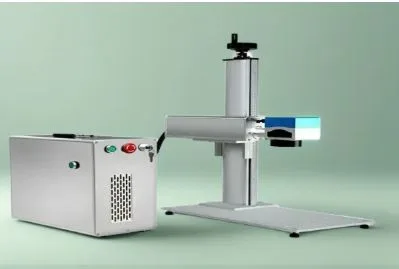Laser Marking Machine: The Complete Guide to Laser Engraving and Marking Systems
Understanding Laser Marking Technology
Laser marking is the process of engraving or labeling a material surface using a highly focused laser beam. This process is non-contactive, meaning it can leave marks on a variety of substrates (metals, plastics, ceramics, or glass) precisely and permanently. Because of the durability, accuracy, and the intricate details the mark possesses without damaging the material, laser marking is extensively used in industries in applications like product identification, traceability, branding, and decorative purposes.
Click here to read more about the Top CNC Laser Marking Machine Manufacturer and Supplier in China – UDTECH.
How Laser Marking Machines Work
For more in-depth information, you should view Laser Marking Machine Manufacturer – UDTECH.
Laser marking machines work by focusing a high-energy laser beam onto the surface of the material to be marked. The beam is focussed using multiple mirrors or galvo scanners, directing the laser beam to the area to be marked. The process the surface undergoes (oxidation, removal, discoloration, or material melting) depends on the material as well as the application of the marking, but the marking is always left permanently. Laser marking machines are capable of precision marking of intricate details like barcodes, serial numbers, logos, and alphanumeric characters, which ensures the highest quality.
Types of Laser Sources Used in Marking
Each of the Laser Marking Machines utilizes a range of Laser sources for different applications and materials as listed below:
Fiber Lasers: Used in the automotive, electronics and medical device industry for marking. They are efficient, faster and more precise in marking metals and tough plastics.
CO2 Lasers: Used on wood, leather, glass and acrylic. CO2 Lasers engrave organic materials and are versatile in their application due to the high quality which is engraves.
UV Lasers: Particularly useful for glass, delicate ceramics and some plastics. They are the best for materials which don’t require high temperatures since they over mark the materials.
Green Lasers: Used on gold, copper and silver. These reflective materials are easy to mark on due to the optimal absorption provided by these lasers.
There are differences in the application and advantages of each laser type and each industry is free to choose a type which most covers their needs.
Applications of Laser Marking Machines
The relative ease of use and versatility of laser marking and engraving has guaranteed their adoption in various fields of industry, precision technology being one of them. Some of the major industries utilizing laser technology include:
Automobile Industry: Focused laser marking is employed to trace critical engine components such as engine parts, VIN numbers, and even certain peripheral interior controls so as to ensure compliance with their sustainable development and safety traceability standards.
Medical Industry: The correct marking of surgical instruments and devices like implants with serial numbers and barcodes ensures surgical tools are sterilized and tracked.
Electronics Industry: Various compact and delicate electronic components such as circuit boards, chips and connectors are etched and marked with clarity so as to not damage the delicate materials.
Aerospace Industry: High-performance aerospace components undergo rigorous marking for identification and quality assurance. Marking with a laser is done on materials that are extremely durable.
Jewelry and other luxury items: Engraving with a laser enables the user to leave delicate and intricate designs on metals, gemstones, and other luxury materials, allowing for personalization and extreme customization.
Advantages of Laser Marking Across Applications
Engraving and marking with a laser offers a number of powerful benefits over older marking techniques, which have given rise to their widespread adoption across various industries.
Durability: Laser etchings are resistant to considerable physical and chemical wear and are difficult to eliminate even in the harshest conditions.
Precision: With the ability to create complex intricate designs, lasers can mark down the minutest of details, enabling their application in highly advanced micro-marking systems and intricate designs.
Less Impactful on the Environment: Less toxic and devoid of consumables, laser technology lowers its pollution footprint.
Effective: Unlike traditional systems, maintenance is low and recurring material costs do not exist, increasing the overall value of the equipment over time.
Universal: With the ability to mark various materials such as metals, plastics, ceramics, and even glass, laser marking displays unparalleled versatility to meet the various material needs.
Focusing on reliability, precision, and multifunctional use, laser marking is setting a new standard in manufacturing and production processes in various industries.
Choosing the Right Laser Marking Machine
Factors to Consider When Selecting a Laser Engraver
It is important to evaluate a few focal points when choosing a laser engraver to ensure the best fit for your specific needs. List out the materials you will be working with first, noting that specific lasers work better with specific substrates. Assess what the machine needs; a higher wattage is usually needed for deeper engravings or heavier materials. Other important features include the level of precision, which, as you can imagine, is very critical for every industry that needs a particular resolution, as well as the speed of the machine. The features of the machine should also include software compatibility, since the set-up should not be a complicated process. Other important aspects to consider are the set price, as well as the operational costs, since they will contribute to the overall maintenance cost of the machine.
Drawbacks of Desktop Laser Marking Systems.
For small and medium operations and budget-restricted laser businesses, desktop laser marking systems could be an optimal choice. They are often narrower, easy to install and operate, and are suited for laser engraving novices and entry-level businesses. Regardless of size, these systems are quite precise and reliable with logo engraving, serial number etching, and barcode engraving. Compared to industrial marking systems, desktop systems are less expensive and also command lower maintenance costs. However, desktop systems, due to their limited output power and restricted work area, tend to be suboptimal for large-scale industrial operations.
Industrial Laser Marking Systems vs Desktop Lasers
Laser marking systems for industries are designed for applications that are high-volume and heavy-duty. Compared to their desktop counterparts, these systems have higher power outputs, faster marking speeds, and larger work areas, which makes them most suited for manufacturing on a grand scale or for production settings that are highly demanding. Such systems are designed for durability and can operate continuously for sustained periods, delivering consistent performance. On the contrary, desktop systems are desktop laser systems that are smaller in size, requiring lower capital and space. Thus, for these features, it is clear that there are two options available: what the workspace is, the budget, and what production there is. In comparison to desktop systems, industrial systems have more features and optimizations suited for extensive operations, whereas desktop systems are more budget-friendly for companies that have marketing requirements that are moderate.
Laser Marking Equipment and Systems
Outline of Equipment for Laser Marking
The laser marking business stands to benefit from advancements to any described features of systems pertaining to every specific application. Competitive fields of use such utilization and demand for fiber, UV, and CO2 lasers, as well as portable laser equipment, range from Compact desktop units to powerful desktop laser machines in places such as industrial laser marking دبي, small business offices, manufacturing companies, and research schließen. Shipping, construction, and other aligned sectors benefit from laser marking equipment is well-matched to heavy industrial, portable applications.
Complete Collection of Laser Marking Systems
Versatile systems laser marking systems configured for any etching, annealing, or engraving process. Hybrid systems are as sought-after as CO2 or fiber laser systems, which are best suited for non-metals and metals respectively, UV markers of utmost precision on delicate surfaces, and gaps do not exist. Value and appreciation of systems stems Laser markers lend ability to utmost precision for metals, ethereal interfaces, and UV sensitive markable surfaces.
New Developments of Laser Marker Technology
Like many advanced technologies, modern laser markers focus on reliability and efficiency while integrating advanced software that automates their operation to increase speed in software-controlled production systems. Many systems feature industry-recognized or proprietary software that facilitates design and configuration for rapid prototyping and production. Real-time monitoring, dynamic multi-articulating and variable speed control, and other task-level energy optimizations promote material and energy efficiency across materials. The range of 3D and other advanced laser marking adds to the value of laser marking technologies by enabling controlled engraving on non-flat workpieces.
Best Practices for Laser Engraving and Marking
Tips for Efficient Laser Engraving
Make Selections Based On Setting
It is important that you select the appropriate power, speed, and frequency settings for the material you are working on. Try your best to not damage the material and optimize the results from your settings by testing them on a sample piece.
Make Sure To Prepare The Surface
To ensure a more precise and efficient output, the surface that the laser is to be placed on should be clean. In the case that there are contaminants like oil, dust, and etc. on the surface, the engraving quality would be hindered.
Make Sure To Properly Focus
Proper focusing ensures that accurate work is done and the best results are achieved..Tools and software that are used with the type of machine being used enable focus for the calibration of the laser.
Improve The Design Files
Having thicker than usual lines within the borders of a design file that is aimed for engraving should be avoided if the goal is for the engraving to be done precisely. Division of the parts of the design helps to avoid any delay that comes from the computer processes.
Think Of The Type Of Materials
It is good to also consider the fact that different materials are used for laser engraving and each one of them would be approached differently, for example, metals, glass, wood, and plastics.
Common Mistakes to Avoid in Laser Marking
Utilization Of Wrong Configurations
Relating to power application and speed, too much can result in damage to the material or the engraving quality will be poor. Again, always reference the material guidelines.
Failure to Address Maintenance
If regular cleaning and maintenance are skipped, it may result in diminished performance and inconsistency in the results.
Failure to Acknowledge materials
Not all materials are appropriate for laser processing. Always check the reverse side of materials to avoid safety and quality issues.
Not Performing Preliminary Tests
Engraving directly onto the final product is not advisable and is extremely risky. Always test the different processes on a sample piece of material.
Incorrect Measurements
If materials are not aligned properly, this will result in markings that are uneven and off-center. Please make use of the alignment tools so that accuracy is met.
Maintaining Your Laser Marking Machine
Routine Maintenance
Follow the equipment manufacturer instructions for required intervals of maintenance of the machine. Ensure the work area, machine mirrors and lenses, and any other windows, mirrors, or optical components are free of particulates and other debris that might hinder the maintenance of and laser’s performance.
Component Inspection
Systematically, within the lens of the mechanical apparatus, check the filters, the cooling apparatus, and the belt for any wear, and repair or replace parts as necessary.
As required, keep the equipment optimally configured with the software necessary to permanently fix any bugs as efficiently as possible and add required features of crashing or software incompatibility.
Controlled Operating Parameters
Maintain proper operation of the apparatus by keeping proper limits to the parameters of the system, within limits of temperature and humidity, so as not to create excessive wear or lower the performance efficiency of the equipment.
Diagnostics and Prognostics in Arrangement
As the equipment is subject to continuous operation, the routine workings should be supplemented with scheduled installations in adequate intervals, so that equipment working wear is compensated by professional servicing by an approved technician, capable to analyze the performance and working points of the apparatus, to trace possible deficiencies in operation.
By implementing such policies, such as keeping routine procedures, one is able to maintain the quality of laser engraving and extend the lifetime of the laser engraving machine.





